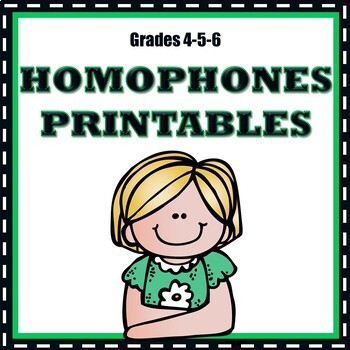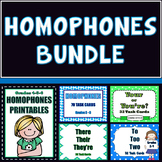Homophones Worksheets
Sue Kelly
256 Followers
Grade Levels
3rd - 12th, Adult Education, Homeschool
Subjects
Resource Type
Standards
CCSSRF.3.4c
CCSSRF.4.4c
CCSSL.3.4a
CCSSL.4.1g
CCSSL.4.4a
Formats Included
- PDF
Pages
34 printables
Sue Kelly
256 Followers
Also included in
- This homophones bundle contain 5 resources containing a total of 34 no prep worksheets and 170 task cards. The products included in this bundle when purchased individually total $15.50 The price of this bundle is $11.95 providing you with a 22% discount and a savings of $3.55! VALUABLE RESOURCE TOPrice $11.95Original Price $15.50Save $3.55
Description
Homophones Printables consist of 34 worksheets.
Students will identify and demonstrate their knowledge of homophones.
The worksheets can be used to supplement lessons, at literacy centers, for morning work, for homework, or for a quick quiz!
Printables include:
- 4 - Identification of homophones
- 2 - to, too, two
- 3 - their, there, they're
- 3 - student uses given homophone to write complete sentence
- 10 - students choose correct homophones to complete sentences
- 11 - match homophones with their definitions
- 1 - word search
Check out these additional resources:
Your or You're - 32 Task Cards
There, Their and They're - 36 Task Cards
My new products are discounted 50% for 24 hours when launched...
If you would like to be informed of my new product launches, sales, etc....click the star below my name!
Total Pages
34 printables
Answer Key
N/A
Teaching Duration
N/A
Report this resource to TPT
Reported resources will be reviewed by our team. Report this resource to let us know if this resource violates TPT’s content guidelines.
Standards
to see state-specific standards (only available in the US).
CCSSRF.3.4c
Use context to confirm or self-correct word recognition and understanding, rereading as necessary.
CCSSRF.4.4c
Use context to confirm or self-correct word recognition and understanding, rereading as necessary.
CCSSL.3.4a
Use sentence-level context as a clue to the meaning of a word or phrase.
CCSSL.4.1g
Correctly use frequently confused words (e.g., to, too, two; there, their).
CCSSL.4.4a
Use context (e.g., definitions, examples, or restatements in text) as a clue to the meaning of a word or phrase.



